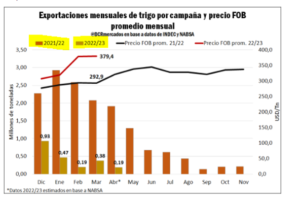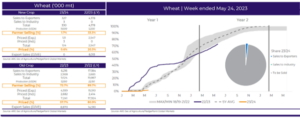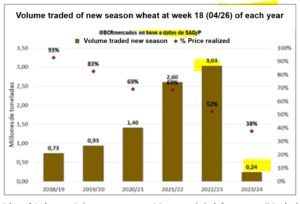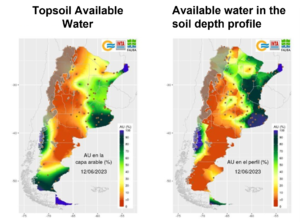The Wheat Market: Scenario for Argentina and Southern Brazil
hEDGEpoint specialists explain the current wheat crop scenario in Argentina and southern Brazil, highlighting the market prospects.
In Brazil, the wheat market is known for its dependence on imports. The country has also been highlighted due to rising production in the southern region. Argentina, in turn, has always been the main exporter of wheat to Brazil, but the 2022/23 harvest of this agricultural commodity was impacted by extreme drought.
According to the United States Department of Agriculture (USDA), Brazilian wheat production in the 22/23 harvest has been estimated at 10.4 million tons, making it the world´s 14th largest producer. Andrey Cirolini, Relationship Manager at hEDGEpoint, emphasizes the great performance of Rio Grande do Sul state for this result:
“The planted area increased considerably in this state, going from 1.165 million tons to 1.5 million tons.“
In Argentina, production reached 12.4 million tons with the 22/23 wheat harvest, representing 8.1 million tons below initial projections. In addition, the tonnage was 10 million less than the record of 22.4 million tons in the previous harvest, meaning a drop of 45%. Sol Arcidiácono, Sales Desk Head at hEDGEpoint, points out that the weather contributed to this significant reduction:
“It was a complex panorama, with a lack of rain, and a severe drought that affected Argentina´s entire productive region, preventing the good development of the crop,” he explains.
22/23 wheat crop marked by historic drought in Arge
The drought situation in Argentina defined the 22/23 wheat crop as the worst in recent years. Due to the erratic climate, many areas were not even planted. The presence of severe drought is strongly associated with the La Niña phenomenon, which lasted three years, ending in March, 2023.
This phenomenon causes a cooling of the Pacific Ocean and is capable of changing the amount of rainfall and temperatures across the planet, with effects on numerous crops. In Argentina, it considerably affected the productivity of wheat sown in the late winter of 2022.
As disclosed by the USDA, wheat exports in the 22/23 season are forecast at 5.8 million tons, destined mainly for Brazil, Indonesia, and other Latin American countries. The BCR (Rosário Commercial Exchange) indicates that the drop in total production of the grain should have significant consequences on revenues: shipments abroad are projected to be 5.6 million tons, a number 40% lower than in the 21/22 harvest.
In the following chart, monthly wheat export estimates for the 2021/22 and 2022/23 harvests are displayed, as well as the average monthly FOB price:

Source: BCR Markets based on data from INDEC and NABSA.
For Sol Arcidiácono, the year was one of the most difficult in memory for Argentine producers, with a drop in expectations and an urgent need for recovery. Many had even sold their production in advance. However, they were unable to complete several of these sales, which had to be extended to the next harvest:
“Grower sales for the cycle being planted are currently at historic lows. This is due to considerably lower prices, and the climate challenge of the transition from La Niña to El Niño this year. Also, the rains will probably not improve until spring. Producers didn´t feel comfortable with the sales acceleration. Political uncertainty is another key factor, since it´s an election year and there´s no favorite candidate,” the hEDGEpoint specialist explains.
This graph illustrates Arcidiácono’s point, showing producer sales up to the week of May 24, 2023:

Source: Argentina Secretary of Agriculture | hEDGEpoint Global Markets
Southern Brazil: Protagonist in wheat production
Despite the historical drought of the 22/23 crop in Argentina, Brazil didn´t feel the impacts of the drought on its neighbor because its need for imports was reduced. According to data from the 9th survey by Conab (Companhia Nacional de Abastecimento) in April, 2023: to meet domestic demand, 312.8 thousand tons of wheat were imported. This number represented 26.96% less than in March, 2023, and 38.87% less than in the same period last year. Of the total quantity imported, 54.79% is from Argentina.
The reduction is due to the fact that we harvested a larger crop, with the industry originating mainly in the domestic market. Andrey Cirolini clarifies: “Brazil has greatly increased wheat production, reaching a record of 10 million tons. We locked in a greater amount of production, so we also reduced our dependence. In addition, the South Region still was able to export almost 3 million tons.”
Rio Grande do Sul is a protagonist in this context: in the 22/23 harvest, 6.01 million tons of wheat were produced there, on a total of 1.6 million hectares. Weather conditions for wheat in RS were vital for the positive results.
“The weather was favorable for wheat production in Rio Grande do Sul, with La Niña contributing to a dry spring, which favors cultivation at harvest time. Before, Paraná occupied the main producer role. However, in recent years, it´s been losing this status to Rio Grande do Sul state. Rains at the end of the crop cycle last year caused quality problems in Paraná wheat, creating the need to export approximately 300,000 tons of feed wheat, which contributed to the consolidation of this scenario,” Cirolini pointed out.
Market perspectives point to an Argentine recovery
According to hEDGEpoint analysis, the outlook is for an Argentine recovery and a return to a balance of exports to Brazil with the 23/24 wheat harvest. In this way, it provides for the re-establishment of the market´s usual functioning.
The estimate for the Argentine nation is to reach the production of 18 million tons for the 23/24 harvest, after planting 6.3 million hectares, according to the Buenos Aires Grain Exchange. The USDA has a more optimistic estimate than local sources, projecting 19.5 million tons.
Note in the graph below the wheat volume traded in the new campaign in the 18th week of each year, given the area + wheat production in Argentina:

“In Argentina, the current advance of wheat planting is almost 40% in mid-June. There´s an expectation of better production, driven by El Niño, which should bring more rain in the second half, even though investment in fertilizers will be lower this year,” Sol Arcidiácono affirms.
Take a look at the water volume on the surface layer of the soil, and in the profile up to 6/12/2023:

In Brazil, the wheat harvest for the 23/24 season has been estimated at 10 million tons, according to USDA information. Stocks were indicated at 1.83 million tons, with exports of 3.50 million tons. States such as Rio Grande do Sul and Paraná already have sown areas, initiating vegetative development.
It’s important to observe the possible impacts of El Niño on production in the South Region. In Santa Catarina, Conab expects a smaller cultivated area and a drop in productivity due to the weather phenomenon as Andrey Cirolini highlights.
“With the arrival of El Niño, there´ll be a risk of more rain in the winter and spring months, which could negatively impact the wheat crop. Thus, both productivity and crop quality could be affected. We need to stay alert,” the hEDGEpoint specialist advises.
How can you protect yourself from this market’s risks?
Despite all the predictions being made, it’s vital to keep in mind that these are just trends. It´s not possible to avoid events such as political changes, and other unpredictable events like storms and economic conflicts, at both a local and global level.
In markets as volatile as those of commodities, risk management is critical. At hEDGEpoint, we bring together the extensive knowledge of specialists with hedging products that always offer you the best experience in futures operations. Your business receives valuable analysis and insights to securely plan, and identify strategic opportunities.






